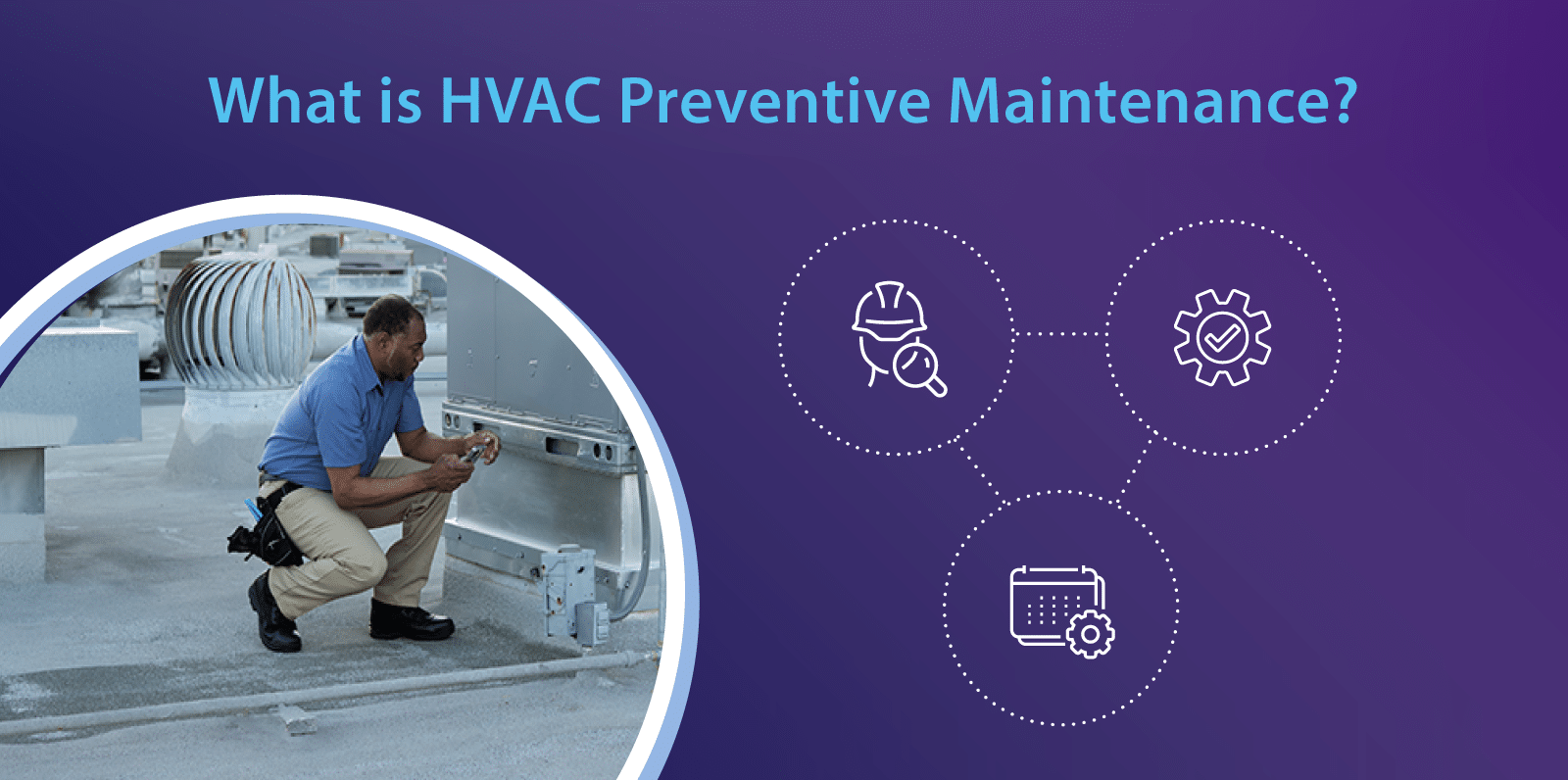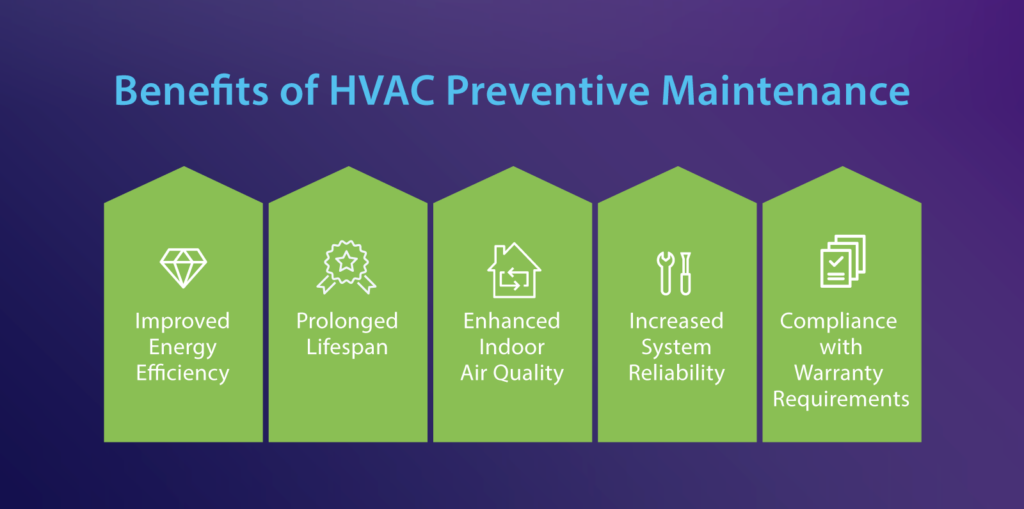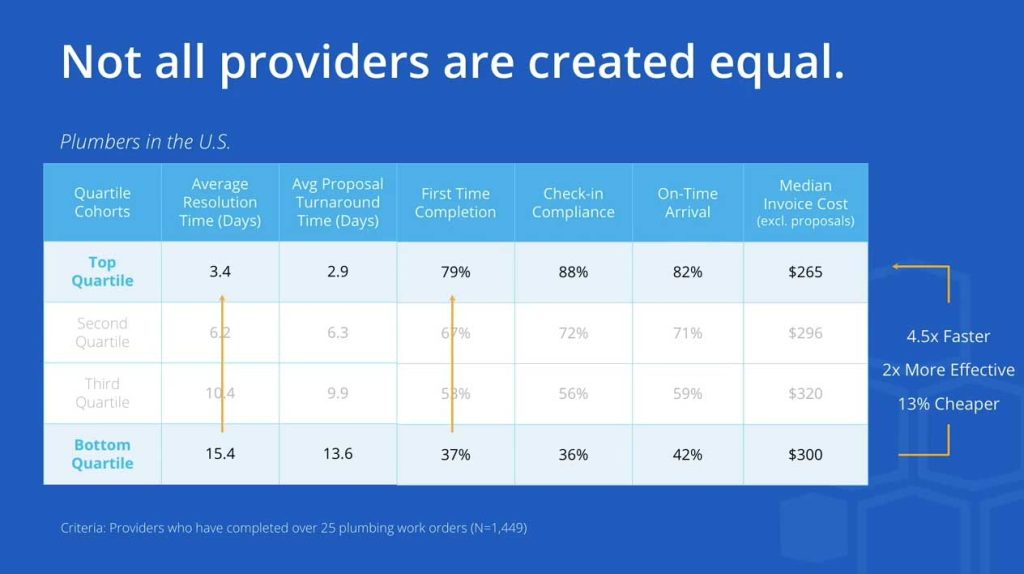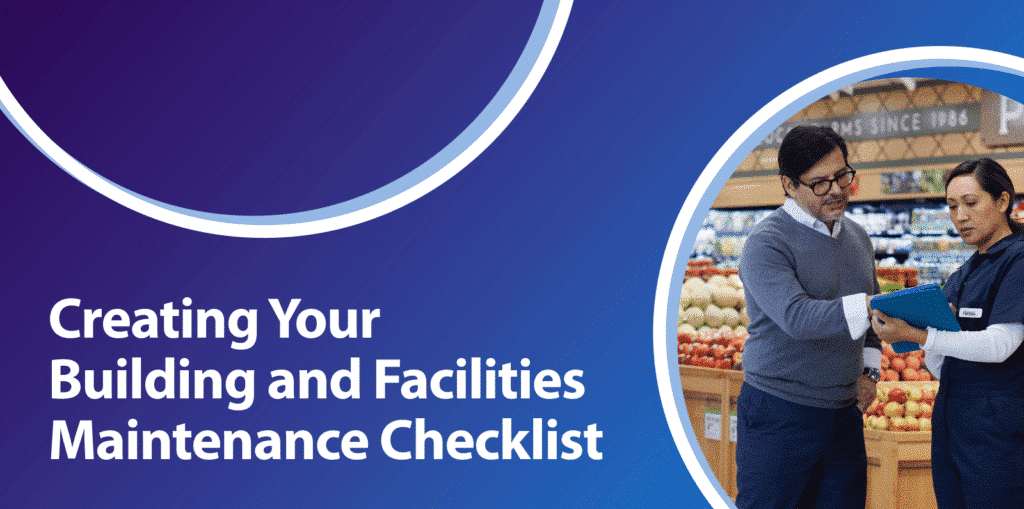A Comprehensive Guide to Commercial HVAC Preventive Maintenance

Learn the essentials of commercial HVAC preventive maintenance, including key tasks, components to manage, compliance requirements, and benefits.
Preventive maintenance reduces failures, controls costs, and keeps equipment reliable. The goal is to find and fix potential system failures before they escalate into costly repairs. Facility managers in all industries must utilize a preventive maintenance plan in some form to keep their assets reliable. However, commercial HVAC system performance is particularly important due to its impact on commercial building air quality.
Your HVAC maintenance team should follow a replicable HVAC preventive maintenance checklist to maintain indoor air quality. This will help your facility managers improve indoor air quality and enhance energy efficiency.
Key Takeaways:
- Routine commercial HVAC maintenance reduces the risk of unplanned downtime and improves efficiency
- Components that need scheduled maintenance include air handlers, ductwork, condensers, coils, thermostats, refrigerant lines, and filters
- Proper maintenance improves energy efficiency, extends equipment life, and enhances indoor air quality
- Regular maintenance supports compliance with standards such as EPA Section 608, ASHRAE 55 and 62.1, UMC, and IMC
- Using maintenance software helps facilities streamline scheduling, track service history, and manage technicians
What Is HVAC Preventive Maintenance?
HVAC preventive maintenance is the routine servicing of heating, ventilation, and air conditioning systems to keep them running efficiently. Performing regular HVAC maintenance tasks will help decrease your risks of unexpected system failures and other air conditioning challenges.
Many commercial HVAC systems are fully serviced twice a year, but certain parts may require more based on usage. Examples of such parts include the following.
- Air filters require more frequent replacement in high-traffic buildings or dusty environments
- Evaporator and condenser coils need to be cleaned more often in locations with heavy pollution or pollen
- Drain lines and pans require more frequent inspections in humid regions to prevent water damage
- Refrigerant levels must be monitored more closely in older HVAC units
Common HVAC Components Requiring Maintenance
Air Handlers & Ductwork
Air handlers move heated or cooled air through the ductwork and into different areas of a building. If filters clog or fans slow down, airflow drops. As a result, heating and cooling become uneven throughout your facility. Ducts can also develop leaks. These leaks force the HVAC system to work harder, which leads to unnecessary energy consumption.
Condensers & Coils
Condensers and coils help transfer heat, either by removing it from indoor air or releasing it outside. When these parts collect dirt or develop corrosion, heat transfer slows down. Blocked coils can also cause the unit to overheat or shut down unexpectedly.
Thermostats & Control Systems
Thermostats and control panels manage how and when the HVAC system runs. Faulty sensors or outdated controls can create false readings. Regular checks help confirm the settings are correct and the system responds as expected.
Refrigerant Lines & Filters
Refrigerant lines carry the coolant that absorbs and releases heat during the HVAC unit’s cycle. Leaks or damage in these lines drastically reduce system efficiency. Additionally, air filters protect internal components from debris. Regular air filter replacement supports clean airflow and HVAC equipment reliability.
HVAC Preventive Maintenance Checklist
Daily
| Check system status via your building automation system (BAS) or thermostat | To confirm that all commercial HVAC systems are operating normally |
| Verify that temperature setpoints are correct | To keep your commercial building comfortable and ensure energy efficiency |
| Look for unusual noises, smells, or visible leaks | To catch the first signs of major problems |
Weekly
| Inspect air filters for visible dirt or clogs | Dirty filters impede proper airflow and reduce energy efficiency |
| Clear debris from outdoor units | Leaves or other debris can clog outdoor units and reduce system performance |
| Verify that electrical connections are secure | Secure electrical connections prevent system failure |
Monthly
| Clean or replace air filters (every 2 weeks if your building is in a dusty environment) | Clean filters support airflow and air quality |
| Test thermostat calibration | Accurate thermostats prevent over- or under-cooling |
| Check refrigerant pressure (if system allows access) | Correct refrigerant levels keep the system cooling properly |
| Inspect belts and pulleys for wear | Worn belts can slip, crack, or snap, which stops the fan from running and causes the unit to shut down or overheat |
Yearly
| Clean condenser and evaporator coils | Clean coils allow better heat transfer, which reduces strain on compressors |
| Calibrate controls and sensors | Accurate temperature and humidity readings prevent overcooling and short cycling |
| Inspect electrical parts | To identify loose wires, corroded terminals, or failing components before they cause outages |
| Lubricate motors and moving components | Reducing friction in motors, fans, and bearings helps prevent overheating and extends equipment life |
| Test gas furnace combustion (if applicable) | To check for leaks, verify combustion levels, and prevent carbon monoxide buildup |
Why Commercial HVAC Preventive Maintenance Is Required
Improved Operational Efficiency & Comfort
A clean, well-maintained HVAC system moves air more effectively and maintains steady temperatures. That means your employees and customers will stay more comfortable during business hours. Plus, better airflow reduces the strain on the system, which means it will need less energy to function.
Extended HVAC Equipment Life
Regular maintenance keeps your HVAC units and their parts in good condition. It’s also a way to catch early signs of emerging issues before they cause lasting damage that would necessitate a full system replacement. You save money on costly downtime and premature HVAC system replacements.
Cost Savings
Routine maintenance lowers repair costs because it lets your team address issues early. It also improves energy efficiency, which will reduce your facility’s utility bills. Over time, these savings often outweigh the cost of scheduled maintenance tasks.
Regulatory Compliance
HVAC systems must meet health, safety, and environmental standards set by local and national regulations. Regular maintenance helps businesses stay in compliance by keeping systems clean, safe, and up to code. These standards will vary depending on the compliance frameworks your facility must follow. Here are some examples:
- EPA Section 608 requires technicians to be certified before handling refrigerants of any type
- The EPA requires leak repair within 30 days if systems with >50 lb of refrigerant leak above federal thresholds. These thresholds are:
- 10% for comfort cooling
- 20% for commercial refrigeration
- 30% for industrial refrigeration
- The EPA’s SNAP program requires the use of approved low-GWP refrigerants in new equipment
- ASHRAE 55 requires HVAC systems to maintain proper airflow as well as a specific temperature and humidity for occupant comfort
- ASHRAE 62.1 specifies minimum outdoor air rates, ventilation design, maintenance of filters, and IAQ monitoring to assure acceptable indoor air quality
- Uniform Mechanical Code (UMC) mandates regular installation inspections and maintenance of duct systems, combustion air, and overall mechanical safety
- International Mechanical Code (IMC) enforces rules for outdoor air intake, exhaust discharge, and duct sizing to protect indoor air quality
5 Benefits of a Proactive HVAC Maintenance Plan
Beyond meeting requirements, a good HVAC maintenance strategy will also offer key benefits for your commercial HVAC equipment. Here is a list of examples:

1. Improved Energy Efficiency
Proactive maintenance can help your system operate at high energy efficiency. As a result, you’ll see lower energy bills and maximize your equipment’s performance.
2. Prolonged Lifespan
When an HVAC system is properly maintained, it typically lasts significantly longer than the manufacturer’s expected lifespan. A longer lifespan can help you save thousands of dollars in replacement costs, which can be used for other things.
3. Enhanced Indoor Air Quality
A well-maintained system improves air quality, which cuts down on airborne illnesses and germs. When indoor air quality suffers, the facility can become a health hazard. This prevents situations where these instances may occur.
4. Increased System Reliability
HVAC systems are reliable when properly maintained. Reliable systems cut down on the need to address breakdowns or pay higher costs for replacement parts.
5. Compliance With Warranty Requirements
Commercial HVAC systems have warranties that won’t be honored if the company can’t provide adequate maintenance records. These records ensure that any breakdowns beyond your control are covered.
How to Build an HVAC Preventive Maintenance Program
1. Audit All HVAC Assets
List every piece of HVAC equipment in your building, including units on rooftops, in mechanical rooms, and in isolated areas. Collect key details such as model numbers, locations, age, and maintenance history to understand what equipment needs the most attention. Following asset management best practices will help make this step easier.
2. Assign Frequency & Task Lists
Decide how often each HVAC asset needs maintenance based on its usage, condition, and manufacturer guidelines. Create detailed task lists for technicians to follow during each HVAC service. This will build consistency and reduce the risk of your team missing important procedures.
3. Leverage CMMS or Work Order Software
Use a computerized maintenance management system (CMMS) or work order software to organize and schedule maintenance. These tools help you track work history, assign jobs, and manage inventory. A digital system makes it easier to stay on top of needed maintenance work without delay.
4. Monitor Performance & Optimize
Review maintenance logs and equipment performance data to spot trends. If needed, adjust your maintenance schedule or procedures to better keep HVAC equipment running at optimal performance. Monitoring system performance helps keep your maintenance program effective in the long term.
Find Out Why ServiceChannel Contributes to a Well-Maintained HVAC System
Commercial HVAC systems are constantly in use at high levels. Having a plan and preventive maintenance schedule in place can keep the assets working without experiencing high energy costs from parts breaking down, downtime from broken systems, or confusion about what was checked and what wasn’t.
Using a CMMS solution can help keep things in check and streamline the preventive maintenance process. The right platform can track service tasks, log inspection results, and send reminders to maintenance managers so you can avoid missed steps.
Explore ServiceChannel to find that solution. Our work order software tool makes it easy to track which HVAC units need maintenance when, and our marketplace can help you find the right HVAC service providers for your indoor and outdoor units.



